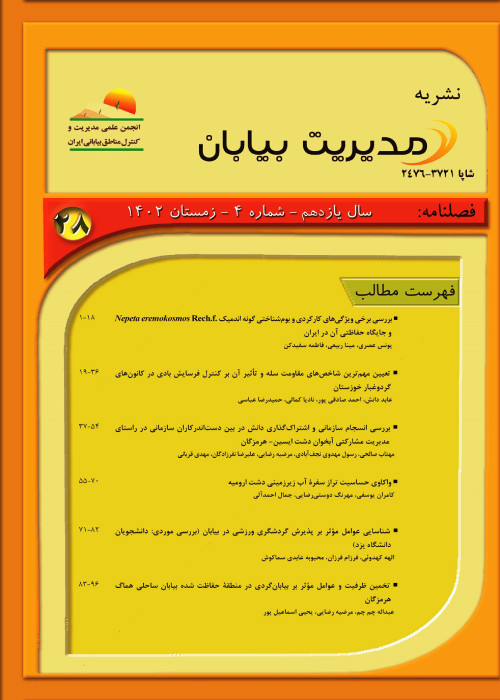Prediction of Land Use and Land Cover Changes in Arid and Semi-Arid Regions Using Satellite Images and Markov Chain Models (Case study: Doviraj Basin, Ilam Province)
Author(s):
Abstract:
Land cover and land use change occurs during the time due to human activities. Identification and detection of these changes can help planners and managers to recognize the effective factors which cause the changes, and use them at different levels of planning. Studying the rate of resources changes and destruction, and prediction and feasibility study of these changes in future years may play a key role in planning and optimal use of resources and controlling undesirable changes in the future. There are various methods for predicting land use and land cover changes, among them the Markov Chain model can be pointed out. In this study, by using the Landsat satellite data of TM (1995) and ETM+ (2000 and 2007) sensors, complementary data of the study area and Markov Chain model the changes occurred in land use and land cover over the past 22 years in Doviraj region of Ilam province are investigated. After performing required corrections on the satellite images and field visits, different land use classes were defined, the training samples were selected and the accuracy of obtained results was evaluated using Kappa coefficient. The results indicate the decreasing trend of forest cover and average rangeland areas of the region (i.e. 2.9 and 17.07 percent, respectively) and increasing trend of poor rangelands, agricultural lands, residential areas and barren land uses (9.17, 2.96, 0.4 and 7.44 percent, correspondingly) which represent total destruction in the region and replacement of weaker land uses. Finally, using Markov Chain model, the status of land use classes in the next 14 years (2021) has been predicted. The results from changes prediction matrix based on the maps of 2000 and 2007 showed that in the time period of 2007-2021 it is probable that 62% of forest lands, 38% of average rangelands, 64% of poor rangelands, 72% of agricultural lands, 69% of residential areas and 76% of barren lands remain unchanged. The average rangelands are of the highest stability and on the other hand poor rangelands have the lowest stability. The calibrated land use maps by Markov Chain model can be employed as an alarming system about the effects and consequences of future land use changes.
Keywords:
Language:
Persian
Published:
Desert Management, Volume:2 Issue: 3, 2014
Pages:
61 to 76
magiran.com/p1497200
دانلود و مطالعه متن این مقاله با یکی از روشهای زیر امکان پذیر است:
اشتراک شخصی
با عضویت و پرداخت آنلاین حق اشتراک یکساله به مبلغ 1,390,000ريال میتوانید 70 عنوان مطلب دانلود کنید!
اشتراک سازمانی
به کتابخانه دانشگاه یا محل کار خود پیشنهاد کنید تا اشتراک سازمانی این پایگاه را برای دسترسی نامحدود همه کاربران به متن مطالب تهیه نمایند!
توجه!
- حق عضویت دریافتی صرف حمایت از نشریات عضو و نگهداری، تکمیل و توسعه مگیران میشود.
- پرداخت حق اشتراک و دانلود مقالات اجازه بازنشر آن در سایر رسانههای چاپی و دیجیتال را به کاربر نمیدهد.
In order to view content subscription is required
Personal subscription
Subscribe magiran.com for 70 € euros via PayPal and download 70 articles during a year.
Organization subscription
Please contact us to subscribe your university or library for unlimited access!




